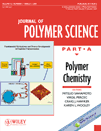Poly(phenylene vinylene)-based copolymers containing 3,7-phenothiazylene and 2,6-pyridylene chromophores: Fluorescence sensors for acids, metal ions, and oxidation
Abstract
A novel copolymer, poly(N-hexyl-3,7-phenothiazylene-1,2-ethenylene-2,6-pyridylene-1,2-ethenylene) (P3), containing N-hexyl-3,7-phenothiazylene and 2,6-pyridylene chromophores was synthesized to investigate the effect of protonation, metal complexation, and chemical oxidation on its absorption and photoluminescence (PL). Poly(N-hexyl-3,8-iminodibenzyl-1,2-ethenylene-1,3-phenylene-1,2-ethenylene) and poly(N-hexyl-3,7-phenothiazylene-1,2-ethenylene-1,3-phenylene-1,2-ethenylene) (P2), consisting of 1,3-divinylbenzene alternated with N-hexyl-3,8-iminodibenzyl and N-hexyl-3,7-phenothiazylene, respectively, were also prepared for comparison. Electrochemical investigations revealed that P3 exhibited lower band gaps (2.34 eV) due to alternating donor and acceptor conjugated units (push–pull structure). The absorption and PL spectral variations of P3 were easily manipulated by protonation, metal chelation, and chemical oxidation. P3 displayed significant bathochromic shifts when protonated with trifluoroacetic acid in chloroform. The complexation of P3 with Fe3+ led to a significant absorption change and fluorescence quenching, and this implied the coordination of ferric ions with the 2,6-pyridylene groups in the backbone. Moreover, both phenothiazylene-containing P2 and P3 showed conspicuous PL quenching with a slight redshift when oxidized with NOBF4. © 2004 Wiley Periodicals, Inc. J Polym Sci Part A: Polym Chem 42: 1272–1284, 2004




